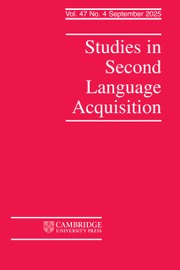Article contents
THE EFFECTS OF TEXTUAL ENHANCEMENT ON THE ACQUISITION OF TWO NONPARALLEL GRAMMATICAL FEATURES BY SPANISH-SPEAKING LEARNERS OF ITALIAN
Published online by Cambridge University Press: 11 March 2016
Abstract
This article investigates the learning of two syntactic structures in Italian—Pre-possessive Determiner Article (PPDA) and Differential Object Marking—that each pose specific learning difficulties for Spanish-speaking learners of Italian (SSLI), resulting from the asymmetrical relationship with corresponding structures in the learners’ L1 (Spanish). The article also examines to what extent these difficulties can be alleviated by means of a relatively implicit type of form-focused instruction (Textual Enhancement, or TE). SSLI tend to omit the article before the possessive determiner (e.g., *mia macchina) and overuse the Prepositional Accusative (PA, the Romance languages’ instance of Differential Object Marking) in canonical SVO sentences (e.g., *conosco a Marco). Although both structures pose learning difficulties to SSLI, the learning path that leads SSLI to acquire these two features is different: SSLI have to learn to add PPDA to their interlanguage and they have to unlearn PA, a property of their L1. Sixty-eight instructed SSLI were divided in two groups. Group A read five texts where the absence of PA was textually enhanced; group B read the same texts where the presence of PPDA was enhanced. The participants took a timed grammatical judgment test before, shortly after, and two months after the instructional treatment. The results show that the effects of the TE are different for PA and PPDA, which indicates that features to be unlearned are more difficult and require more explicit instructional intervention.
Information
- Type
- Articles
- Information
- Studies in Second Language Acquisition , Volume 38 , Special Issue 2: Cognitive Perspectives on Difficulty and Complexity in SLA , June 2016 , pp. 217 - 238
- Copyright
- Copyright © Cambridge University Press 2016
References
REFERENCES
- 9
- Cited by


